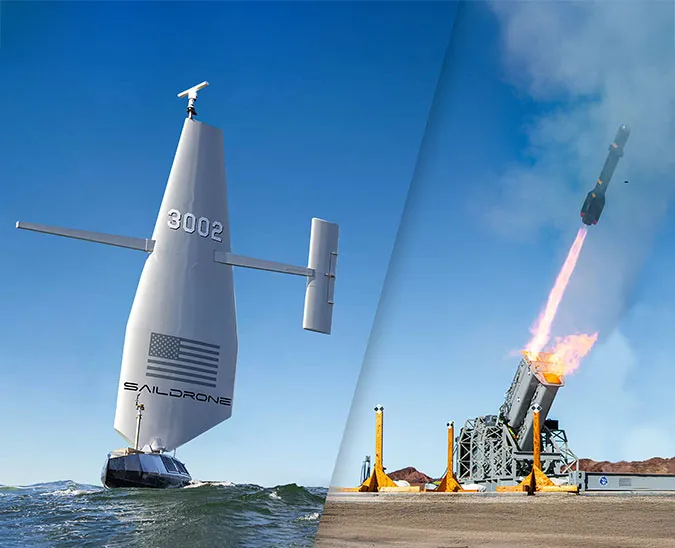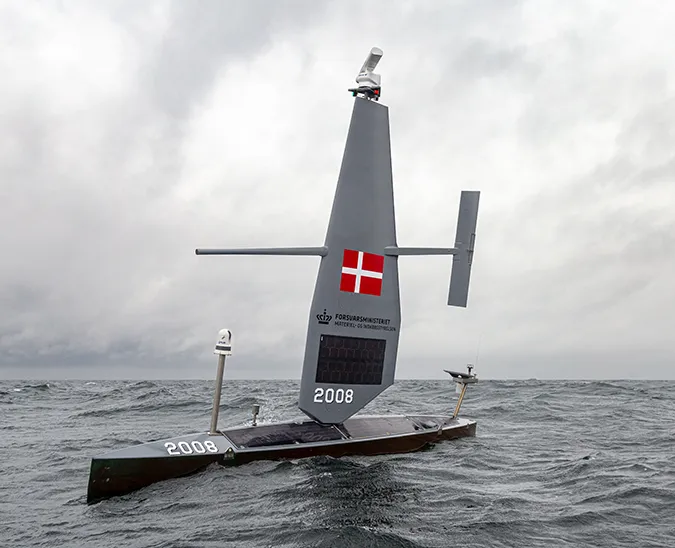Published on
Author
Just a few years ago, a bright orange Saildrone unmanned surface vehicle (USV) loaded with science sensors was a novelty sailing in the Arctic waters north of Dutch Harbor, AK. These days, it’s all but commonplace.
Earlier this month, Saildrone, in partnership with the National Oceanic and Atmospheric Administration (NOAA) and the National Aeronautics and Space Administration (NASA), deployed six USVs on a mission to survey ongoing changes in the Arctic ecosystem and their impact on the food chain, sea ice, and climate and weather systems.
This is the fifth year in a row saildrones have conducted missions in the Arctic region, and it’s the largest fleet of saildrones ever deployed at one time.
In 2015, NOAA/PMEL, the University of Washington, and Saildrone explored the use of unmanned surface vehicles (USVs) in the Bering Sea to demonstrate the ability of the platform to conduct oceanographic research in a harsh, high-latitude environment. During the 2016 Bering Sea Mission, part of the Innovative Technology for Arctic Exploration (ITAE) program, two saildrones conducted acoustic fish surveys of walleye pollock, observed the presence of the critically endangered North Pacific right whale, and tracked tagged northern fur seals. The following year, three saildrones continued the walleye pollock surveys and fur seal research in the Bering Sea, and also completed the first autonomous crossing of the Bering Strait to measure CO2 concentrations in the Arctic. Last year, four saildrones on two concurrent missions measured ocean currents and air-sea carbon flux and surveyed Arctic cod in the Chukchi Sea. In total, saildrones have traveled some 45,000 nautical miles on NOAA Arctic missions to date.
This summer, five saildrones will sail north into the Chukchi Sea on a three-month climate science mission. The sixth saildrone will remain in the Bering Sea to conduct fish stock surveys.

Improving Arctic sea ice predictions
The primary difference between the Arctic and Antarctic polar regions is that Antarctica is a continent frozen in the ice, whereas the Arctic ice cap is made up of sea ice floating on the surface of the Arctic Ocean. Arctic sea ice is typically two to three meters (6.5 ft – 10 ft) thick, and it grows, melts, and moves with the seasons. It’s instrumental in moderating the global climate, and also presents a significant danger to vessels in the region.
NASA satellites gather daily data on the extent of Arctic sea ice, but there are few in situ observations that can be used to validate them. Knowing the location of the ice edge is critical to the safety of any vessel attempting to enter the Arctic. For the first time, saildrones will sail as close to the Arctic ice edge as possible to enhance sea ice prediction.
“PMEL has pioneered the application of saildrones to study the marine ecosystem in the open water away from sea ice. This year, we plan to approach the sea ice—as close as we can. The saildrones gather a much richer, high-resolution dataset to supplement foundational data collected by buoys and vessels used to build forecasting models today,” said Chidong Zhang, a PMEL oceanographer leading the mission to enhance sea ice prediction.
A single Saildrone data set is often used for many purposes. Data collected this summer in the Arctic will not only be used to improve NOAA and NASA satellite temperature measurements, it will also be available to weather agencies around the world for operational use.
Earth & Space Research oceanographer Chelle Gentemann is the principal investigator on another interagency effort (funded by the National Oceanographic Partnership Program) collaborating with Dr. Zhang on a subset of the NOAA missions. “We are helping to ensure that the saildrone observations are used by NOAA, NASA, and US Navy scientists for weather forecasting and satellite sea surface temperature measurements in the Arctic,” said Gentemann. “The near-ice edge observations taken this summer will be especially important for understanding the accuracy of these satellite observations.”
This visualization shows the expanse of the annual minimum Arctic sea ice for each year, 1979 – 2018, as derived from passive microwave data. The graph overlay shows the area in million square kilometers for each year's minimum day. Video: NASA/Goddard Space Flight Center Scientific Visualization Studio.
Studying air-sea carbon flux and ocean acidification
Once the near-ice edge portion of the mission is complete, two saildrones will split off from the group to study air-sea carbon flux and the effects of ocean acidification.
“I am extremely excited to be deploying carbon sensing equipment in the far north for the third year in a row,” said PMEL oceanographer Jessica Cross, who works with NOAA’s Arctic Research and Ocean Acidification Programs in support of the Distributed Biological Observatory (DBO). “This is an amazing partnership because the DBO has such a great time series of ecosystem impacts and a history of close community and indigenous relationships. That helps put our carbon work in a real-world context and ensure that our research has the highest impact that it can.”
Saildrone USVs carry a customizable suite of science sensors to collect meteorological and oceanographic measurements above and below the sea surface. The standard sensor package includes an anemometer to record wind speed and direction, an AT/RH to measure air temperature and humidity, a Dual GPS aided IMU to calculate significant wave height and dominant wave period, an ASVCO2 to measure the partial pressure of CO2 in the atmosphere and surface ocean, and either an Acoustic Doppler Current Profiler (ADCP) or echo sounder. These cutting-edge ocean vehicles can also be outfitted with a remote optical watcher (ROW) to detect oil on the sea surface using fluorescence.
“Working with autonomous technologies is allowing us to collect more data than we ever have before. We’re swimming in it!” said Cross. “It’s very exciting to be able to reach these remote areas with cutting-edge scientific equipment. Especially this year, when we are able to work so close to the ice—this is really the scientific frontier.”

Northern fur seals and prey in the Bering Sea
The Bering Sea is home to the largest population of northern fur seals and the largest U.S. walleye pollock fishery, the fur seals’ primary source of nourishment. Local fur seal populations have fallen 80% in the past half century, and critical information about the relationship between fur seals and their prey needed to explain the decline is still lacking. Continuing the work of past missions, one saildrone equipped with an echo sounder will remain in the Bering Sea.
Carey Kuhn, an ecologist with NOAA’s Alaska Fisheries Science Center, investigates the feeding behavior of female fur seals using traditional at-sea tracking techniques, combined with Saildrone surveys of available fish and seal cameras, which provide a unique “seal’s-eye view” of fur seal foraging trips. Kuhn says multi-year data are critical to building accurate models and understanding the impacts of changing ocean conditions on the depleted northern fur seal population.
“Having this additional year to conduct research gives us the opportunity to examine how annual variability in the fur seals’ habitat impacts fur seal foraging,” she said.
The saildrones deployed from Dutch Harbor, AK, to sail north toward the survey areas in the Bering and Chukchi Seas on May 16. Once the mission objectives have been completed, the saildrones will return to Dutch Harbor for retrieval. The total mission is expected to last three months.
Resources:
Follow the Saildrone 2019, NOAA Pacific Marine Environmental Laboratory, accessed May 28, 2019
“A Sharper View of the Ice Edge,” National Snow and Ice Data Center, accessed May 28, 2019
“Quick Facts on Arctic Sea Ice,” National Snow and Ice Data Center, accessed May 28, 2019





